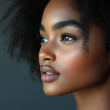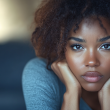Eating disorders have become increasingly prevalent in society. It affects people of all ages, genders, and backgrounds. According to the National Eating Disorders Association, there are at least 20 million women and 10 million in the United States who are affect by eating disorders. These disorders can have serious physical and psychological consequences, including malnutrition, organ damage, depression, and anxiety.
While there are many factors that contribute to the development of eating disorders, including genetics, family history, and trauma, societal pressures and cultural ideals of beauty also play a significant role. The constant barrage of images of thin, flawless models in the media can contribute to feelings of inadequacy and low self-esteem, which can lead to disordered eating behaviors. However, it is important to recognize that eating disorders are complex and multifaceted, and cannot be solely attributed to media influence.
The Role Of Media In Shaping Body Image
The media has a significant influence on how we perceive our bodies and how we should look. The portrayal of thin, toned bodies in advertisements, movies, and magazines has created a societal standard of beauty that is often unattainable and unrealistic. This standard has led many individuals, particularly young women, to develop negative body image and eating disorders. The constant bombardment of images that promote an unrealistic body type can cause individuals to feel inadequate and develop a distorted view of their own bodies. Therefore, media companies should be more responsible in promoting a diverse range of body types and avoid promoting unhealthy body standards.
The Impact Of Social Media On Body Image And Eating Disorders
Social media has become an integral part of our lives, and it has significantly impacted our perceptions of body image. The constant bombardment of images of thin and perfect bodies on social media has led to an increase in body dissatisfaction and eating disorders among young people. The unrealistic beauty standards promoted on social media platforms have made many people feel inadequate about their bodies, leading to unhealthy behaviors such as extreme dieting, over-exercising, and even eating disorders.
The impact of social media on body image and eating disorders cannot be ignored. Social media platforms need to take responsibility for the content they promote and ensure that it does not promote unhealthy body ideals. It is essential to create a safe space where people can feel comfortable in their own skin and not feel pressured to conform to unrealistic beauty standards. Additionally, it is crucial for individuals to be mindful of the content they consume on social media and to seek help if they are experiencing any negative effects on their mental health.
The Relationship Between Thin Models And Eating Disorders
Many studies have found that exposure to images of thin models can contribute to body dissatisfaction and disordered eating behaviors, especially among young women. This is because these images create unrealistic and unattainable beauty standards, which can lead to feelings of inadequacy and low self-esteem. As a result, individuals may engage in extreme dieting, purging, or other harmful behaviors in an attempt to achieve the ideal body type that is often portrayed in the media. However, it is important to note that there are many other factors that contribute to the development of eating disorders, and that exposure to thin models alone is not the sole cause.
The Controversy Surrounding The Use Of Thin Models In Advertising
The use of thin models in advertising has been a controversial topic for many years. Critics argue that the use of extremely thin models sets unrealistic beauty standards and promotes unhealthy body image and eating disorders. On the other hand, some people argue that thin models are necessary for advertising certain products, such as clothing, and that it is up to individuals to make their own decisions about their body image and health.
Despite the controversy, there have been some efforts to promote more diverse body types in advertising. Some brands have started to use models of different sizes and shapes, and there has been a push for more representation of plus-size models in the fashion industry. However, there is still a long way to go in terms of promoting healthy body image and reducing the prevalence of eating disorders in our society.
The Potential Harm Of Promoting Unrealistic Body Standards
The promotion of unrealistic body standards has been a major concern in the fashion industry for decades. The use of thin models in advertising and media has been linked to an increase in eating disorders, body dissatisfaction, and low self-esteem among women and girls. The constant exposure to images of the “ideal” body type, which is often unattainable for most people, can lead to a distorted view of one’s own body and a desire to conform to these unrealistic standards. This can result in dangerous behaviors such as extreme dieting, over-exercising, and even eating disorders such as anorexia nervosa and bulimia. It is important for the fashion industry to promote more diverse body types and to celebrate all shapes and sizes in order to prevent harm to individuals and promote a healthier body image.
The need for greater diversity and representation in media and advertising
The media and advertising industries have long been criticized for their lack of diversity and representation. Many argue that the constant bombardment of images featuring thin, white, and conventionally attractive models and actors perpetuates harmful beauty standards and can contribute to eating disorders and body image issues. By showcasing a narrow range of bodies and faces, these industries exclude and marginalize groups that do not fit into their narrow definition of beauty, leading to feelings of inadequacy and self-doubt for many individuals.
As society becomes more diverse and inclusive, it is essential that media and advertising reflect this reality. This means featuring a wider range of body types, skin tones, ages, and abilities in their campaigns and content. By doing so, these industries can help to break down harmful stereotypes and promote a more positive and inclusive message about beauty and self-worth. It is crucial that we continue to push for greater diversity and representation in media and advertising to ensure that everyone feels seen and valued.
Promoting Body Positivity And Healthy Body Image In Society
It is crucial to promote body positivity and healthy body image in society. The media has a significant impact on how we view ourselves, and the constant bombardment of unrealistic beauty standards can lead to body dissatisfaction and eating disorders. By promoting diverse body types and celebrating individuality, we can help individuals develop a positive relationship with their bodies. It is essential to recognize that everybody is different and that beauty comes in all shapes and sizes. By embracing body positivity, we can create a more inclusive and accepting society where everyone feels valued and respected.





